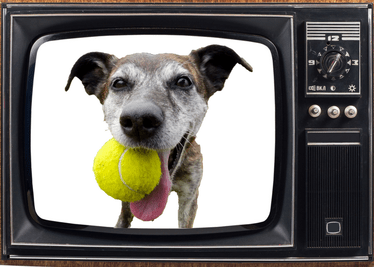The most common answers given to this question are ‘No, dogs can’t see 2D or flat objects’ or ‘No, dogs can't see colour’. Both those answers would be incorrect. It appears dogs can see what is on TV; it just depends on whether they choose to pay attention to it.
So where does this difference of opinion come from? Of course dogs are allowed to react differently to things, they are different in many ways, but after talking to other dog owners with dogs it seems that the younger dogs are definitely the ones that pay attention to the TV and the older ones tend to be those that ignore it. My two dogs react very differently to the TV. My old girl Keira has no time for the TV (unless she hears a puppy crying), on the other hand Kai, who is a lot younger, happily watches TV and often reacts to animals he sees (he even reacts when the TV is on mute so I know it's not the noises!).
The answer is all to do with their eyesight; basically our technology has only recently become good enough for their eyesight.
To explain this we’re going to have to get a bit scientific; it is all to do with something called flicker fusion threshold (more commonly termed ‘flicker rate’)
Flicker rate is the speed at which a light pulses. For example with a TV the flicker rate is the speed the image on the screen is replaced by the next image.
Another example is a fluorescent light. Although it seems to be glowing continuously it is actually flashing at a rate of 120 times per second (120Hz) but because that speed is too fast for our eyes to process so we just see the light as permanently on.
For humans to be able to see the light flicker it would have to be slowed to around 55 times per second (55Hz). Dogs however are much better at detecting movement than we are and their eyes can detect the flicker much easier and it only needs to be slowed down to around 75Hz for them to see the flickering. (That’s nearly 50% faster than us!)
Now here is the important part: average TV screens flicker at about 60Hz. As this is faster than the average human’s detectability it means that to us the images blend smoothly together and appear as one continuous movement. However, as 60Hz is still below the dog’s detectability the television image doesn’t appear continuous, rather: image, black, image, black, image… making the movement on screen much less realistic and therefore not really worthy of attention. It would be the equivalent of us trying to watch a movie on a flipchart…very tedious after a while!
This meant that dogs didn’t pay attention to the TV screen so our older dogs generally have learnt that the TV is something boring and to be ignored. However, thanks to our advancement in technology and the development of HDTV our younger dogs have learnt that the TV can be a great source of entertainment.
HDTVs have been created that have a flicker rate of 120Hz+, this increased flicker rate is now above the dog’s detectability which means that the images on the screen appear as one fluid movement. Therefore the screen is much more realistic and the images on it much more lifelike, especially any animals on screen.
With the popularity of dog’s watching TV there have been many DVD’s released and in the United States there is already a TV channel ‘Dog TV’ which is specifically designed for canine viewers and online there are a series of programmes and movies you can purchase for dogs. Kai had to have surgery at the beginning of the year and couldn’t settle, so I set him up with a calming/relaxing dog video and he soon calmed down and fell asleep.
Do your dogs at home watch TV? Any particular programme their favourite?



